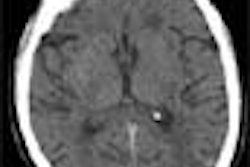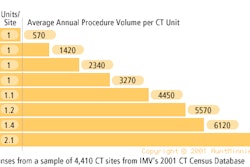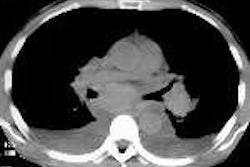CHICAGO - Ever since February, when Dr. David Brenner and colleagues published their now-famous study on the risk of CT-induced cancer in children, concerned radiologists have been searching for safer ways to scan kids (AJR, February 2001, Vol. 176, pp. 289-296).
Radiologists at Children's Memorial Hospital in Chicago have made significant progress toward that goal. At Thursday's pediatric sessions of the RSNA meeting, Dr. Cynthia Rigsby shared the results of her group's study on low-dose pediatric chest CT. For all but the largest patients, dose reductions down to as low as 40 mAs did not reduce physicians' diagnostic confidence in the findings.
"The purpose of our study was to determine the minimum scan technique necessary to achieve diagnostic-quality prospective chest CT images," Rigsby said.
In the study, 148 consecutive patients routinely referred for chest CT were evaluated prospectively. The referrals resulted from variety of suspected pathologies; otherwise, parental consent was the only requirement for inclusion.
The patients were divided into three categories. All of them underwent scanning on a Hi-Speed Advantage scanner (GE Medical Systems, Waukesha, WI), using a normal pediatric chest CT protocol (pitch: 1.5) with all parameters remaining constant except for specified collimation and mA levels, Rigsby said.
Twenty-seven small patients (mean age 1.2 years) weighing less than 12 kg and, were scanned at 5 mm collimation at 110 mAs. Sixty-eight intermediate patients weighed between 12 and 50 kg (mean age 8 years), and were scanned at 130 mAs and 7 mm collimation. Seven large patients (mean age 16.2 years) weighing more than 50 kg were scanned at 150 mAs and 10 mm collimation.
"At the time of the scan, the studies were evaluated for adequacy by the radiologist assigned to CT," she said. "After a minimum of 8 scans in a category had been completed, the scans were blindly, independently, and retrospectively reviewed by a pediatric radiologist. This minimum number was then reduced to six to complete the study."
The images were evaluated on a scale of 1 to 5, 5 being best, based on image quality of the lung parenchyma, mediastinum and chest wall. The readers assigned a score for each of these areas, as well as an overall diagnostic confidence rating. The overall scores were averaged, and whenever diagnostic confidence exceeded 3.0, the mAs were reduced by 20% and the patients rescanned until the lowest possible exposure was achieved, down to the scanner limit of 40 mAs.
Results in all 3 weight categories were similar, with all confidence scores ranging between 3 and 4 for both overall diagnostic confidence and individual components -- down to 40 mAs in all 3 categories. Scan doses were lowered by an average of 66%, and the rate of confidence was the same irrespective of the pathology, Rigsby said.
"All techniques in all categories had average overall diagnostic confidence and individual component scores [between 3 and 4]," she said. "For statistical analysis, we used a regression model with random effects, demonstrating no significant difference in the overall confidence scores between the highest and the lowest techniques in any category. In conclusion, low-dose diagnostic spiral chest CT can be performed in all children in all sizes, without a penalty in image quality. What are we doing with the results of our study? We've chosen to scan all patients at 40 mAs for routine chest CT, knowing that extremely large patients in the range of 80-90 kg may need to have the [dose parameters] increased."
By Eric Barnes
AuntMinnie.com staff writer
November 29, 2001
For the rest of our coverage of the 2001 RSNA meeting, go to our RADCast@RSNA 2001.
Copyright © 2001 AuntMinnie.com



















